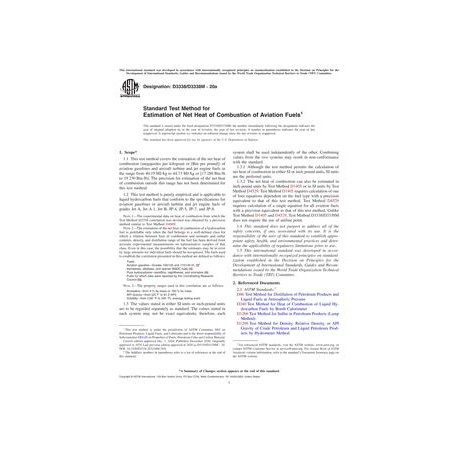No products
 View larger
View larger ASTM D3338/D3338M-20a
M00000566
New product
ASTM D3338/D3338M-20a Standard Test Method for Estimation of Net Heat of Combustion of Aviation Fuels
standard by ASTM International, 12/01/2020
In stock
More info
Full Description
1.1''This test method covers the estimation of the net heat of combustion (megajoules per kilogram or [Btu per pound]) of aviation gasolines and aircraft turbine and jet engine fuels in the range from 40.19'''MJ/kg to 44.73'''MJ/kg or [17'''280'''Btu/lb to 19'''230'''Btu/lb]. The precision for estimation of the net heat of combustion outside this range has not been determined for this test method.
1.2''This test method is purely empirical and is applicable to liquid hydrocarbon fuels that conform to the specifications for aviation gasolines or aircraft turbine and jet engine fuels of grades Jet A, Jet A-1, Jet B, JP-4, JP-5, JP-7, and JP-8.
Note 1:''The experimental data on heat of combustion from which the Test Method D3338 correlation was devised was obtained by a precision method similar to Test Method D4809.
Note 2:''The estimation of the net heat of combustion of a hydrocarbon fuel is justifiable only when the fuel belongs to a well-defined class for which a relation between heat of combustion and aromatic and sulfur contents, density, and distillation range of the fuel has been derived from accurate experimental measurements on representative samples of that class. Even in this case, the possibility that the estimates may be in error by large amounts for individual fuels should be recognized. The fuels used to establish the correlation presented in this method are defined as follows: Fuels: Aviation gasoline'''Grades 100/130 and 115/145 (1, 2)2 Kerosenes, alkylates, and special WADC fuels (3) Pure hydrocarbons'''paraffins, naphthenes, and aromatics (4) Fuels for which data were reported by the Coordinating Research Council (5).
Note 3:''The property ranges used in this correlation are as follows: Aromatics'''from 0'''% by mass to 100'''% by mass API Gravity'''from [25.7'' to 81.2''API] Volatility'''from [160'''''F to 540'''''F], average boiling point
1.3''The values stated in either SI units or inch-pound units are to be regarded separately as standard. The values stated in each system may not be exact equivalents; therefore, each system shall be used independently of the other. Combining values from the two systems may result in non-conformance with the standard.
1.3.1''Although the test method permits the calculation of net heat of combustion in either SI or inch-pound units, SI units are the preferred units.
1.3.2''The net heat of combustion can also be estimated in inch-pound units by Test Method D1405 or in SI units by Test Method D4529. Test Method D1405 requires calculation of one of four equations dependent on the fuel type with a precision equivalent to that of this test method. Test Method D4529 requires calculation of a single equation for all aviation fuels with a precision equivalent to that of this test method. Unlike Test Method D1405 and D4529, Test Method D3338/D3338M does not require the use of aniline point.
1.4''This standard does not purport to address all of the safety concerns, if any, associated with its use. It is the responsibility of the user of this standard to establish appropriate safety, health, and environmental practices and determine the applicability of regulatory limitations prior to use.
1.5''This international standard was developed in accordance with internationally recognized principles on standardization established in the Decision on Principles for the Development of International Standards, Guides and Recommendations issued by the World Trade Organization Technical Barriers to Trade (TBT) Committee.

